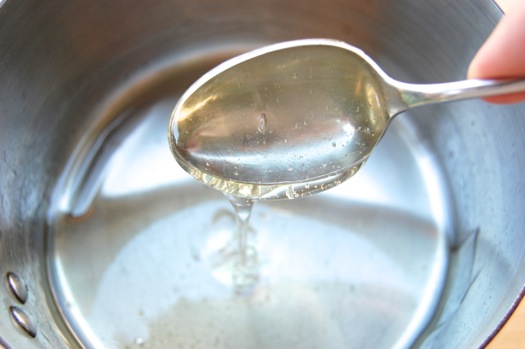About That “Golden” Syrup…

So OK, I’ve been working on a recipe for golden syrup for my mooncakes since I’m told it can be made at home. So far I’ve been meeting with limited success.
But first, what is golden syrup? In Chinese cooking it is an a.) invert sugar syrup that is b.) cooked to the soft ball stage, about 235 degrees Fahrenheit, and is c.) golden.
My product above meets criteria a and b. It doesn’t meet c, which is the problem. But then how can you create “golden” syrup when color in syrup comes from caramelization and caramelization doesn’t happen until 300 degrees Fahrenheit?
This syrup is only cooked to 230 degrees Fahrenheit for the simple reason that if it’s cooked to a higher temperature it ceases to be syrup in the pourable sense and becomes candy, then caramel. So how do you get the color? Recipes I’ve seen for Chinese golden syrup say that all you need to do to get the color is cook the syrup at a very low temperature, bringing it up to 235 degrees over the course of about an hour. Which makes no sense. Of course I tried it anyway, but the results were the same.
So I’m going to try something else here in a minute. Back with my next report shortly.
food colouring is your friend :p
CfDU
Yeah, yeah, thanks for the help, clever dick.
– J
Wouldn’t using something like rice syrup work for the color? Harold McGee had an article about sugar caramelization awhile back. If I remember correctly he heated sugar cubes in a low oven over a long period of time and they did indeed darken below standard temperature.
Hey Dani!
I found another technique for the syrup that worked well and that most people will be able to pull off without too much trouble. But thanks very much for the advice! Cheers,
– Joe
I dunno if you’re ready to “cheat” but the brew stores near me carry Lyle’s Golden Syrup. Don’t know why that’s a beer ingredient but apparently it is important enough for them to keep in stock. Also, if you have Cost Plus World Markets stores near you they carry a number of British items which include Lyle’s.
Now, British is British and Chinese is Chinese but how many variations are there on heating sugar and water and putting it in a bottle?
Hah! Good question. I’m finding out that there are more than I thought!
But you make an excellent point: Lyle’s can indeed be used in place of Chinese golden syrup. I was just curious to try to make it since it’s a bit hard to find in Kentucky. Not impossible, just difficult.
Thanks!
– Joe
Could it be that the color comes from not totally pure sugar? I know “natural” sugars tend to have more of a beige color to them from not all the molasses being removed. Maybe the white sugar in china is more like that than our super refined white sugar.
I made a simple syrup the other day from “Florida Crystals” sugar and it was sort of golden in color.
That’s very interesting and indeed quite true! Even pure cane sugar syrup can have a faint yellow tint as a result of residual molasses, which is why many pastry chefs filter or “bleach” (and I use the term figuratively) theirs for various uses. I don’t think that’s the issue in this particular case, but it’s food for thought!
Cheers,
– Joe
Baking soda?
You know, I bet that could work!
Nice thinking, Ed!
– Joe
Golden syrup is readily available in Australia from the supermarket. It even comes in a handy dandy little squeeze bottle. The only ingredients are sugar and water. I use it like liquid brown sugar – I had some on my porridge this morning, and it is wonderful on freshly baked bread with butter. I believe the colour is the result of making the syrup from cane syrups, not from processed sugar. Perhaps using some brown sugar instead of white sugar would give you the golden colour you so desperately seek?
Maybe if you used brown sugar? Or, heat the sugar enough to caramelise, then add more water and cook again up to the softball stage. Is there something about caramelised sugar that would prevent it from having the right texture when cooked again?
Secondary question: have you/ will you ever post about sugar cooking, especially fudge, but also things like caramel and such?
Cook a small portion first to caramelization (1/2 cup sugar to 3.5 TBSP water). Then add the other ingredients (sugar boiling water and a little lemon juice) and cook to 235. It’s what I did and worked beautifully, or should I say goldenly.
Well don, Joy!
Thanks!
– Joe